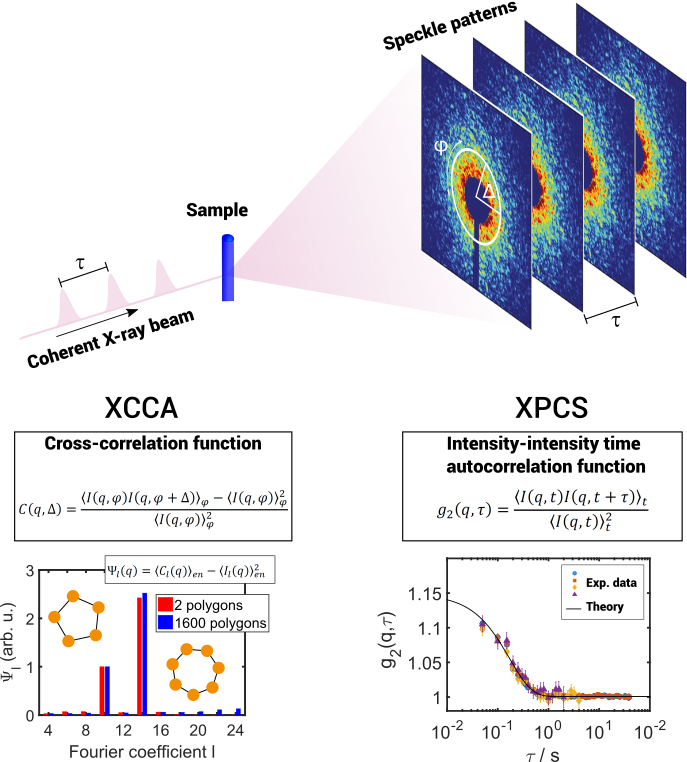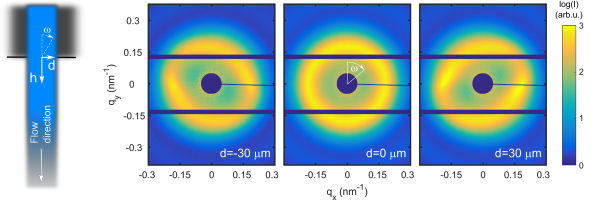Fig. 1: Correlation schemes in coherent X-ray scattering experiments. Left: X-ray cross correlation analysis (XCCA). Right: X-ray photon correlation spectroscopy (XPCS).
In the research field “Complex Liquids” we study structure and dynamics of soft matter, in particular colloidal and aqueous systems. The main focus lies on coherent X-ray scattering experiments at modern synchrotron and free-electron laser sources. These experiments are performed with custom-made sample systems synthesized in our group (see enabling technologies/lab infrastructure) and are accompanied by different characterization methods (UV-Vis spectroscopy, dynamic light scattering, transmission electron microscopy, …) as well as molecular dynamics, Brownian dynamics and Monte Carlo simulations.
Using coherent X-rays as probe, the instantaneous sample structure is encoded in the diffraction pattern, the so-called speckle pattern. Therefore, sample dynamics can be studied by means of X-ray photon correlation spectroscopy (XPCS), tracking changes of the speckle pattern over time. Spatial correlations in the framework of X-ray cross correlation analysis (XCCA) can provide access to higher-order structural information beyond simple pair-correlation functions. Within this research field we develop further and apply these methods for state-of-the-art experiments on liquids, glasses and soft matter systems in different projects outlined below.
Structure and dynamics in soft matter systems and nanocrystal superlattices
Despite intensive studies in the past decades, the local structure of disordered matter is widely unsolved. Scattering methods, typically used to study structure and dynamics on different length scales, allow access to ensemble averaged information only, e.g. the pair-correlation function g(r). Various phenomena in nature are dominated by changes in orientational order while g(r) remains almost unchanged. These structural changes are often accompanied by dynamical heterogeneity, i.e. different regions in the material show different relaxation behavior. In this project we perform XPCS and XCCA experiments to understand the connection of structure and dynamics in different soft matter systems, comprising (1) crystallization and glass transition in colloidal hard spheres and charge stabilized systems, (2) dynamical heterogeneities in soft core-shell systems, and (3) structure formation in colloidal self-assembly processes.
(1) Since colloidal particles can by synthesized in different sizes and shapes, they may show a rich phase diagram including a variety of crystalline and glassy phases. The phase of a colloidal dispersion can be chosen by tuning the interaction potential of the system and controlling the concentration of particles. This makes them excellent model systems to investigate crystallization and glass transition phenomena. We pay special attention on the connection of dynamics and higher-order structural correlations approaching the glass transition or crystallization point in hard sphere and different charge stabilized systems. In particular, we investigate the formation of crystal precursors in supercooled liquids and geometrical frustration as driving force of the glass transition.
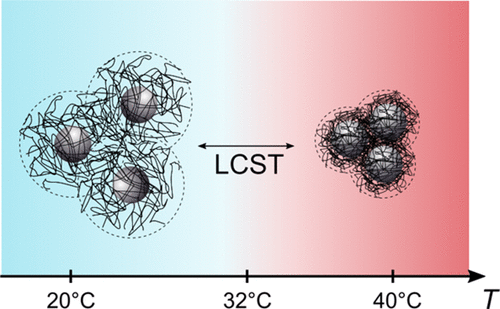
Fig. 2: Schematic Silica- PNIPAM core-shell particles undergoing the volume phase transition at the LCST of 32 °C. Taken from J. Phys. Chem. Lett. 10, 5231 (2019).
(2) In nature, heterogeneity is a frequently observed phenomenon. In particular, soft matter systems are dominated by dynamical heterogeneity, e.g. in glass transition processes discussed in (1). A prominent example showing heterogeneous dynamics over different length scales are polymers. Among those, Poly(N-isopropylacrylamide) (PNIPAM) is in the focus of research due to its reversible phase transition at the lower critical solution temperature, where it transforms from a swollen, hydrophilic state to a collapsed, hydrophobic one around 32 °C. We focus on silica core – PNIPAM shell systems, that are studied from dilute states by means of dynamic light scattering up to dense, crowded states where we apply XPCS to follow the sample dynamics in different swelling states.
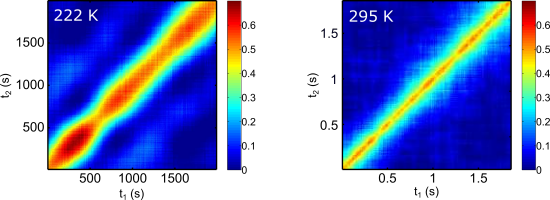
Fig. 3: Two-time correlations in a polymer (PPG4000) measured by XPCS. At lower temperature close to the glass transition of the polymer, oscillations along the diagonal t1=t2 are visible that reflect the heterogeneous nature of the sample dynamics. From H. Conrad et al. Phys. Rev. E 91, 042309 (2015).
(3) The ability of colloidal nanocrystals to form ordered structures by self-assembly is an attractive way to obtain functional devices. However, due to limited understanding of intricate interactions between colloidal particles in a solvent-mediated assembly process, the materials based on nanocrystal assemblies are still far from their utilization. Therefore, detailed control and understanding of the self-organization of colloidal particles and their interactions in the course of drying is desirable. Here, we study (i) the in-situ assembly process by X-ray scattering and (ii) the structure of self-assembled films and clusters by means of XCCA to reveal the underlying mechanisms of self-assembly processes.
References
F. Lehmkühler et al. IUCrJ 5, 354 (2018).
I. Lokteva et al. Small 15, 1900438 (2019).
L. Frenzel et al. J. Phys. Chem. Lett. 10, 5231 (2019).
I. Lokteva et al. J. Phys. Chem. Lett. 10. 6441 (2019).
L. Frenzel et al. Soft Matter 16, 466 (2020).
A. Jain et al. Soft Matter 16, 2864 (2020).
F. Dallari et al. Sci. Adv. 6, eaaz2982 (2020).
F. Lehmkühler et al. Sci. Adv. 6, eabc5916 (2020).
F. Schulz et al. Adv. Mater. Interf. 7, 2000919 (2020).
Water and hydrogen bond systems
The structure and properties of liquid water is one of the most fascinating topics in natural science and has been discussed controversially for over one century. Supercooled water in particular has been proposed to show a variety of local structures ranging from clathrate-like clusters to mixtures of high and low density structures in the framework of the two liquids hypothesis. However, experimental studies were not able to prove such models so far. With the advent of hard X-ray FEL sources it is possible for the first time to take snapshots of the instantaneous structure of water using ultrashort coherent X-ray pulses. In this way both spatial correlations via XCCA and dynamics via XPCS become accessible.
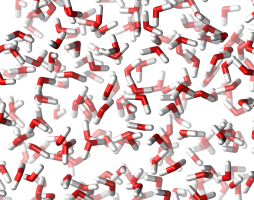
Fig. 4. Molecular Dynamics simulation snapshot of liquid water.
Within this project we aim to facilitate coherent X-ray scattering experiments on liquid water at ambient and supercooled conditions. Therefore, a liquid jet sample environment has been developed and is used in coherent X-ray scattering experiments at FEL and storage ring facilities. The experiments are complemented by molecular dynamics simulations benchmarking structural and dynamical properties from ambient to deeply supercooled conditions.
References
I. Steinke et al. Rev. Sci. Instrum. 87, 063905 (2016).
F. Perakis et al. PNAS 114, 8793 (2017).
F. Perakis et al. Nat. Commun. 9, 1917 (2018).
F. Lehmkühler et al. PNAS 117, 24110 (2020).
Soft Matter under Shear
The response of soft matter systems to shear has increased scientific and technological interest in the last decades. Especially sheared dense colloidal dispersions show complex behavior such as shear thinning and thickening, that is, the reduction or increase of the dispersion’s viscosity with shear rate. While such macroscopic properties are studied for decades, the connection of these phenomena with the microscopic structure of the material is widely limited to simulation and theory studies. With state-of-the-art sample environments and focused X-ray beams structural rheology experiments have recently become possible accessing the appropriate time and length scales of soft matter systems.
Fig. 5: Schematics of a liquid jet (left) and three diffraction patterns measured across the a liquid jet formed by a suspension of silica nanoparticles in water (right). The anisotropy of the patterns close to the edge of the jet reflect shear-induced ordering of the particles. See F. Lehmkühler et al. J. Phys. Chem. Lett. 8, 3581 (2017).
In this project we study the structural and dynamical response of soft matter systems to shear. We use two different experimental approaches: (1) Investigation of flow-induced structures in liquid microjets and (2) study of higher-order correlations during structure formation in RheoSAXS geometry.
(1) Due to the small dimensions in microfluidic environments, shear rates in the order of 105 s-1 and larger can be achieved by tuning flow rate and channel size. This exceeds standard rheology approaches by at least two orders of magnitude, allowing for studies at extreme conditions. In order to resolve structure formation in micrometer dimensions, we perform X-ray scattering experiments with beam sizes in the (sub-)µm regime. In this way we can access information on structure formation in colloidal dispersions at high shear rates that are necessary to study shear thickening and thinning phenomena. Furthermore, structural relaxations back to the unsheared structure are investigated using liquid jets by following the structure along the travel direction of the liquid downstream the nozzle tip.
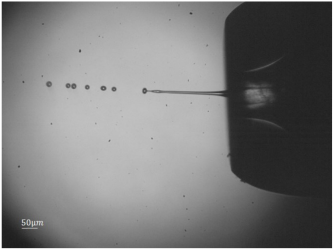
Fig. 6: Liquid jet produced by a gas dynamic virtual nozzle.
(2) Using conventional structural rheology environments (e.g. plate-plate or Couette geometry) we investigate the structure formation in colloidal dispersions. By means of XCCA we can quantify the degree of order during the transition from a disordered structure of the sample at rest into a hexagonal layered one under shear as function of different parameters. Unlike the experiments in (1) the shear rate is tuned between 0 s-1 and approximately 1000 s-1 allowing for detailed view into the phase behavior of soft matter systems. These experiments are accompanied by XPCS to access sample dynamics under shear.
References
F. Lehmkühler et al. J. Phys. Chem. Lett. 8, 3581 (2017).
V. Markmann et al. Struc. Dyn. 77, 054901 (2020).
Correlation methods at modern X-ray sources
With the advent of hard X-ray free-electron laser sources, coherent X-ray pulses with durations in the femtosecond regime became available for accessing structure and dynamics at unprecedented length and time scales. The higher average flux and superior degree of coherence allow to access larger wave vector transfers q and short timescales down to femtoseconds. Furthermore, improvements in detector technology and the development of diffraction-limited storage rings will allow access to sample dynamics down to micro- and nanoseconds. Likewise, the detection of speckle patterns with such short exposure times enables the detection of higher-order correlation functions at unprecedented time scales with molecular and atomic resolution.
In this project we develop coherent x-ray scattering at new X-ray sources. Special attention is paid on the demonstration and application of XPCS and XCCA to study structure and dynamics of different types of samples. These experiments are accompanied by different computational and simulation approaches.
References
F. Lehmkühler et al. Sci. Rep. 5, 17193 (2015).
F. Lehmkühler et al. IUCrJ 5, 801 (2018).
F. Perakis et al. Nature Comm. 9, 1917 (2018).
F. Lehmkühler et al. J. Appl. Cryst. 52, 777 (2019).
F. Lehmkühler et al. PNAS 117, 24110 (2020).





